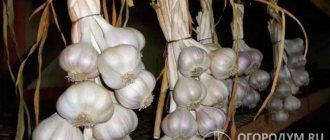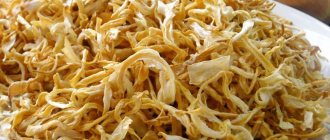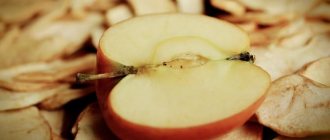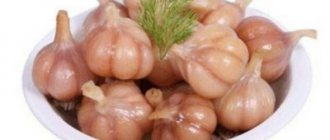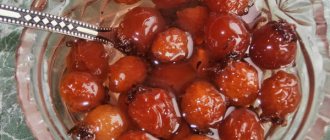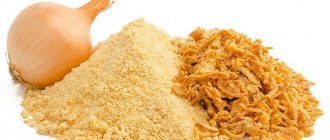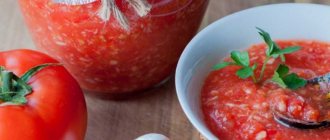Dried garlic is useful not only in the off-season. Storing heads at home is not always convenient; this requires space and a certain microclimate.
On average, 2.5 kg of fresh garlic can be turned into 0.5 kg of dried product, which will easily retain its properties, and store it in a jar on the kitchen cabinet shelf. To do this, you need to work a little and fulfill certain requirements for drying the product. But the result of the work will please you throughout the year.
What are the benefits of dried garlic?
Garlic is not only an aromatic seasoning, without which many dishes cannot fully reveal their taste, but also a real storehouse of useful minerals and vitamins: K, Mg, Z, Se, Cu, Mg, Fe, Co, P, Na, B, C, E, PP, choline. Eating dried garlic, like fresh garlic, has a beneficial effect on health, as it contains phytoncide - a natural antibiotic in the fight against fungal diseases and viral infections.
Regular consumption of garlic in moderate doses improves immunity, lowers cholesterol, improves heart function, reduces the risk of strokes and heart attacks, combats helminthic infestations, and is used in the treatment of diseases and the prevention of impotence in men. Garlic is not used for diseases of the digestive system.
If dried properly, the vegetable will retain its beneficial properties. In order not to cause harm, you must remember that dried garlic is a concentrated product, and this fact must be taken into account when consuming.
What conditions must be met for proper drying?
Dig in dry weather. It is clear that the less moisture a vegetable contains, the easier it is to dry it. That is why garlic needs to be harvested in dry weather, so that there is no rain or watering for several days before harvesting.
It is recommended that cleaning be done around noon or in the afternoon. It is also not recommended to wash the vegetable, as it will take a long time to dry and may become moldy.
Collect ripened garlic. By the time of harvesting, the garlic should be fully ripe, as evidenced by yellowed or fallen foliage. Unripe bulbs are not dense, loose, and dry poorly. Overripe ones - when dug up, they fall apart into cloves, which lose their covering scales and are smeared with earth, which complicates further processing, since the cloves cannot be washed.
Head sorting. For drying, dry, clean, healthy bulbs are selected, without signs of disease, damage, or mold. The heads must be well formed. If the outer scales are not damaged, then the teeth inside will be clean, without soil.
Disassemble into teeth. If the method of drying peeled garlic is chosen for work, then the heads are first freed from the husks covering them, and the cloves are carefully inspected for damage, dents, and stains. The root neck of the cloves is cut off.
Cut. For drying, garlic must be cut in such a way that no juice is squeezed out of it. That is why the graters and food processors available in the household are not suitable for slicing. It is best to arm yourself with a thin, sharp knife. Cut the cloves for drying:
- in an electric dryer - across with thin plates;
- in natural conditions - in long slices, cutting the cloves in half.
It is desirable that these plates are no thicker than 5 mm. They are laid out for drying with the cut side up, so the juice will not drain.
Attention! To prevent burns to your hands, you must use rubber gloves. The room is ventilated, since the high concentration of garlic vapor quickly irritates the mucous membrane of the nose and eyes.
Rules for harvesting bulbs
Digging up the crop is an integral part of preparing plants for storage. Improper harvesting of fruits can affect the integrity of the heads, which will cause rapid spoilage of the bulbs.
- The main indicator of crop ripening is the foliage of the plant. As soon as most of it has turned yellow, the garlic can be dug up.
- Also, to determine the ripening of the bulbs, one arrow is left on the bed. The appearance of seeds indicates the readiness of the variety.
- Species that are planted for the winter are usually dug up closer to August. Spring varieties can ripen until mid-autumn.
Plants should be dug up as carefully as possible. First, the bulb is dug up, after which the garlic is pulled out of the ground by the base of the stem. After harvesting the garlic, the soil should be dug up and planted with green manure. If this is not done, the soil will lose many useful substances.
How to dry garlic - possible methods at home
In the sun
Immediately after digging up the garlic, it is laid out on a ridge so that the tops and roots dry. In the field, the vegetable can be dried in dry weather with partly cloudy weather.
The plant cannot be dried under the scorching rays of the sun, otherwise the teeth will get burned. In damp, rainy weather, garlic should not be left in the field either.
It is transferred to a dry, well-ventilated room or under a canopy and laid out on mesh or lattice bases. After the tops have dried, they are cut off, leaving low stubs (3-5 cm), and the roots are trimmed to the root collar (0.3 cm). During drying, the scales will tightly envelop the bulb and ripen.
In conjunction
Garlic is often braided or tied into small bunches and hung on the walls or attic in a dry, cool, ventilated room. In this state it can be stored for fresh use or further deep drying.
Without destroying the bulbs
One of the methods for producing dried garlic for long-term storage. The hard husks are completely removed from the heads, without disassembling the onion into cloves. Subsequently, the cloves are cut into pieces, no thicker than 5 mm, placed on baking sheets covered with parchment and sent to the oven or oven. Dry at a temperature of 50°C, stirring and ventilating. Dried garlic is winnowed to remove any remaining husks.
Peeled garlic
With this method, the cloves are completely freed from scales, cut into thin slices, laid out on parchment and sent to a dryer or oven.
Important! When drying, do not allow condensation to accumulate, so as not to steam the vegetable, but to dry it.
To do this, the door of the dryer or oven is periodically opened, and the raw materials are turned over or mixed.
In the sun
To dry garlic cloves in the sun, you need to choose a clean place, and the weather outside must be appropriate.
Step-by-step description of the procedure for drying garlic in the sun:
- Chop the garlic cloves into slices. Prepare plywood sheets, trays with small sides, mesh or baking sheets.
- Transfer the prepared slices to the selected container in one even layer. Place the workpiece in the sun, choosing a place that will be blown by the wind. This will help the garlic cloves dry out faster.
- Turn the product over, mix and stir regularly. The workpieces should not stick to each other. Depending on the degree of drying, pour the plates into one tray.
Completely dried garlic can be transferred to one container. For these purposes, it is recommended to use a box or plywood box. A storage room or barn that is well ventilated is suitable as a room.
It is not advisable to send garlic immediately for storage, since there may be slightly damp specimens among the dried plates. If the product is immediately transferred to a closed container, they will become moldy and ruin the entire seasoning.
However, this method has a number of negative qualities:
- when drying outside, dust particles will settle on the product;
- The dried product must not be moistened before cooking;
- wet workpieces cannot be ground with a coffee grinder.
How to properly dry garlic
In room
Vegetables can be dried naturally only in a well-ventilated, dry room, so that the sun does not fall on it. The cloves, cut in half, are laid out on a flat surface with the cut side up, periodically inspected and moved. Even under good conditions and dry weather, the drying process takes at least 10-15 days and there is a risk that the material will become moldy.
In the oven
Garlic cut into thin slices is placed on a baking sheet covered with baking paper. The temperature in the oven should be no more than 50-60°C. Every 30 minutes, remove the baking sheet from the oven, turn the plates over, cool and put them back in the oven. To allow air to enter, do not close the door tightly. The drying process will take from 3 to 8 hours, depending on the condition of the source material.
In an electric dryer
For this method, the onions are cut into thin transverse slices and laid out in one layer on a wire rack. You can use a special mesh spacer to prevent small petals from falling into the grid. The optimal temperature for drying is 50°C.
At temperatures above 60°C, garlic will begin to lose its beneficial substances and aromatic properties.
Basic Rules
Every beginner can grow garlic; the main thing is to properly harvest the crop, prepare for drying and further storage. To do this, follow a number of rules:
- To prevent garlic from accumulating excess moisture, the beds are not watered before harvesting.
- Choose a variety suitable for drying.
- Only mature, healthy crops are suitable.
- The weather for the harvesting period is chosen to be as warm, clear, and without precipitation as possible.
- After harvesting, initial drying is carried out in the garden or in the shade under a canopy.
- Determined using the secondary drying method.
- Placed for further storage.
How many days should the heads be dried?
Vegetables are carefully dug up with a pitchfork. After harvesting, the plant is laid out on the surface of the beds. It takes a little time for the vegetables to dry. The plants are turned several times during drying. After a few hours, the harvest is sent under the canopy. Here the garlic is left for a decade.
Temperature
In rainy weather, the temperature at the beginning of drying is set to 25 degrees and gradually increased to 40 degrees. The garlic should dry until the husk is completely dry.
Subsequently, spring garlic is stored at a temperature of 16-18 degrees, low humidity. Winter varieties require storage at high humidity, low temperature - 2-4 degrees.
Place
After digging, the garlic heads are dried in the garden bed, under a canopy, on the balcony, terrace, or attic. The main thing is that the place is ventilated. Gazebos and warm, non-humid rooms are suitable.
What if the weather is rainy?
The garlic must be ripe when digging. Overripening of the crop is not allowed. Otherwise, the products will not be able to be stored for a long time. The weather is not always favorable - the ripening phase may coincide with the rainy season.
In this case, the dug heads are cleaned of dirt and sent to dry. The heads, which have been completely dried, are calibrated and damaged, rotten specimens are removed.
In what form should I use it: powder or seasoning?
- Powder.
To produce the powder, garlic, well dried using one of the listed methods, is used. It should break when bent. Grind the records using a coffee grinder or blender. The grind size can be chosen as desired. To isolate a larger fraction, the grinding can be sifted through a sieve.
- Seasoning.
For seasoning, the bulbs can be dried alone or with other ingredients. In this case, dense varieties of tomatoes, carrots, and apples are used. Everything is cut into thin rings or half rings. As it dries out, add herbs (basil, dill) to the free spaces.
The video shows a recipe for dried garlic powder in an electric dryer.
How to use
Properly dried garlic retains all its properties and can be used in the preparation of meat, fish, and vegetable dishes, as a flavorful addition to sauces, soups, and salads. It can complement the taste of even dairy products. Cottage cheese mixed with herbs, vegetable oil and garlic powder is not only a tasty but also a healthy snack. Garlic powder is also used to combat ants at home and in the garden.
Even when all the fresh shelf life of winter and spring garlic has expired, the prepared dried vegetable will retain its delicate aroma and beneficial properties for you.
Can all varieties be dried?
Experts advise drying hot varieties of garlic, for example:
- Rostovsky;
- Alka;
- Bronnitsky;
- Bashkir;
- Ukrainian white;
- Dubkovsky;
- Kirovogradsky;
- Jubilee Gribovsky;
- Creole;
- Otradensky;
- Silver-white;
- Danilevsky;
- Kalininsky;
- Broadleaf;
- Southern purple;
- Sail;
- Starobelsky;
Other varieties can also be dried, but in the process not only moisture is lost, but also taste.
